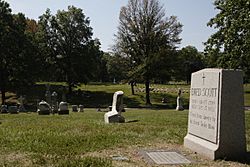Calvary Cemetery (St. Louis) facts for kids

Dred Scott's grave in Calvary Cemetery
|
|
| Lua error in Module:Location_map at line 420: attempt to index field 'wikibase' (a nil value). | |
| Details | |
|---|---|
| Established | 1854 |
| Location | |
| Country | United States of America |
| Type | Catholic |
| Owned by | Roman Catholic Archdiocese of St. Louis |
| Size | 470 acres (190 ha) |
| No. of graves | 300,000 |
Calvary Cemetery is a large Catholic cemetery in St. Louis, Missouri. It is managed by the Archdiocese of St. Louis. Founded in 1854, it's one of the oldest cemeteries in the area.
Calvary Cemetery covers about 470 acres of land. It has more than 300,000 graves. Many famous people are buried here. These include General William Tecumseh Sherman, Dred Scott, and writer Tennessee Williams.
Contents
History of Calvary Cemetery
A New Cemetery for St. Louis
In 1849, a serious illness called cholera spread through St. Louis. It caused the deaths of over 4,000 people. Because of this, city leaders made a rule. They said no new cemeteries could be built inside the city. They hoped this would stop more people from getting sick.
At the same time, the cemeteries already in St. Louis were almost full. They had no more space.
Archbishop Peter Richard Kenrick saw that a new, larger cemetery was needed. In 1853, he bought a farm from Senator Henry Clay. This farm was a few miles northwest of St. Louis.
Opening and Growth
Archbishop Kenrick set aside the eastern part of the farm for the new cemetery. He lived in the old Clay Mansion on the western part. Calvary Cemetery opened for burials in 1854. Archbishop Kenrick was its first president.
Before Calvary Cemetery was built, parts of the Clay farm were used for burials. Native Americans and soldiers from nearby Fort Belle Fontaine were buried there. After 1854, their remains were moved to a special mass grave. This grave is under a large crucifix at one of the highest points in the cemetery.
Graves from other Catholic cemeteries in St. Louis were also moved to Calvary. As more people were buried, the cemetery grew. It eventually reached its current size of 470 acres. Today, it has over 300,000 graves. It also has public and private mausoleums.
Famous Burials and Monuments
Calvary Cemetery has enough space for new burials for many years. Many people who once lived in St. Louis choose to be buried here. For example, August Chouteau X, a descendant of St. Louis's founder, was brought back here for burial. The brother of famous writer Tennessee Williams also chose to have him buried here.
In 2003, a special monument was built at Calvary Cemetery. It honored four Nez Perce men. These men traveled to St. Louis in 1831 from their home in Idaho. They could not find anyone who spoke their language. Two of them, Black Eagle and Speaking Eagle, died in St. Louis. They are buried in Calvary Cemetery.
Notable People Buried at Calvary
Many important people are buried at Calvary Cemetery. Here are some of them:
- Louis Auguste Benoist (1803–1867), a pioneer banker.
- Mary Odilia Berger (1823–1880), who founded a group of nuns called the Franciscan Sisters of Mary. They run hospitals.
- Thomas Biddle (1790–1831), a military hero from the War of 1812.
- Lewis V. Bogy (1813–1877), who was a U.S. Senator.
- Martin Stanislaus Brennan (1845–1927), a Catholic priest, scientist, and writer.
- Patrick E. Burke (c. 1830–1864), an officer in the Union Army during the Civil War. He was also a state legislator.
- Mickey Carroll (1919–2009), one of the "Munchkins" in The Wizard of Oz movie.
- Alfonso J. Cervantes (1920–1983), a former Mayor of St. Louis.
- Louis Chauvin (1881–1908), a talented ragtime musician.
- Kate Chopin (1851–1904), a famous author.
- François Chouteau (1797–1838), a fur trader and businessman who helped found Kansas City, Missouri.
- René Auguste Chouteau (1740–1829), a fur trader and one of the co-founders of St. Louis.
- Powhatan Henry Clarke (1862–1893), a United States Army officer and Medal of Honor recipient.
- Pierre-Jean De Smet (1801–1873), a Belgian Jesuit priest and missionary to Native Americans.
- Thomas Anthony Dooley III (1927–1961), a doctor and humanitarian.
- Charles and Ray Eames, famous designers and architects.
- Daniel M. Frost (1823–1900), a brigadier general in the Confederate States Army.
- Charles Gratiot (1786–1855), a Chief Engineer for the United States Army Corps of Engineers.
- Robert E. Hannegan (1903–1949), a St. Louis politician.
- Martin Wilkes Heron (1850–1920), a bartender who created the drink Southern Comfort.
- John Joseph Kain (1841-1903), a Roman Catholic Archbishop of Saint Louis.
- Ted Kennedy (1865–1907), who invented the baseball catcher's mitt. He is in the Baseball Hall of Fame.
- Peter Richard Kenrick (1806–1896), the first Catholic archbishop west of the Mississippi River.
- Charles Lucas (1792–1817), an entrepreneur and legislator.
- John Baptiste Charles Lucas (1758–1842), a U.S. Representative.
- Alexander McNair (1775–1826), the first governor of Missouri.
- James T. Rapier (1837–1883), one of Alabama's black congressmen during Reconstruction.
- Thomas C. Reynolds (1821–1887), a Confederate governor of Missouri.
- Phyllis Schlafly (1924-2016), an author known for her political activism.
- Dred Scott (1799–1858), a slave who sued for his freedom. His case went to the U.S. Supreme Court.
- Ellen Ewing Sherman (1824–1888), wife of General William Tecumseh Sherman.
- William Tecumseh Sherman (1820–1891), a U.S. Army general famous for his "March to the Sea" during the Civil War.
- Antoine Soulard (1766–1825), a surveyor for the Spanish government.
- Marie Julia Cérre Soulard (1775–1845), a landowner who donated land for the Soulard Farmers Market in St. Louis.
- Raymond Tucker (1896–1970), a former mayor of St. Louis.
- John Wesley Turner (1833–1899), a Union Army general during the Civil War.
- Tennessee Williams (1911–1983), a famous American playwright who won the Pulitzer Prize.


